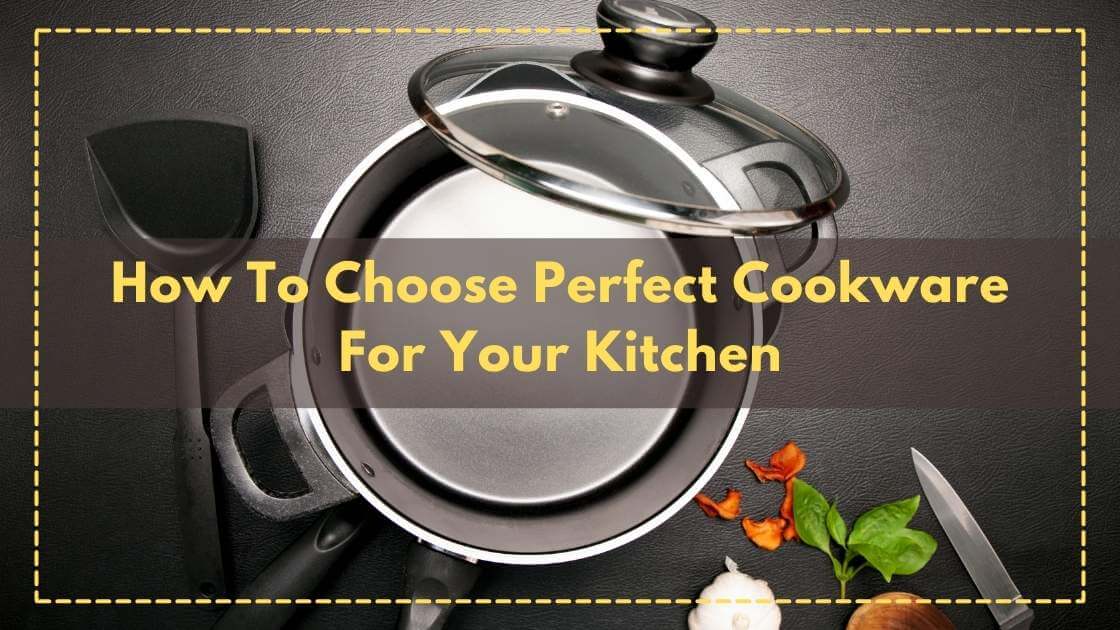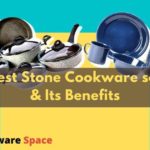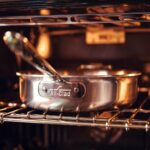How To Choose Perfect Cookware For Your Kitchen – Universal Guide

Cookware is one of the most important tools in any kitchen. It can be the difference between a gourmet meal and a disaster. With so many different types, materials, sizes, and shapes of cookware available on the market, how do you know which one is right for you?
This guide will help you choose the perfect cookware for your kitchen.
Construction Material
The first and only thing that decides how your cookware will perform is the construction material(1). It determines how evenly your food will cook, how durable it is, how easy it is to clean, how long it will last, and what sort of maintenance it will require.
There are three primary types of materials used in cookware construction: aluminum, stainless steel, and cast iron.
Stainless steel
Stainless steel is the most durable type of cookware. It is resistant to scratches, dents, and corrosion. Stainless steel is a good choice for cooking at high temperatures.
However, it is not a good conductor of heat and is also nonstick, so food can stick to the bottom of the pot or pan.
Benefits of Stainless Steel Cookware
- Standard benefits:
- Durable – resistant to scratches, dents, and corrosion
- Dishwasher Safe
- Even-Heat distribution (Tri-Ply)
- Induction Safe
- Endure high heat
Who Should buy?
If you’re looking for Cookware for cooking at high temperatures and recipes that require searing, then, stainless steel is a great choice.
If you have an Induction Cooktop, then only stainless steel cookware with a magnetic bottom will work on it.
Not all Stainless Steel is created equal. Some are made with just one or two layers of stainless steel while others have a core of aluminum or copper for better heat conductivity (Tri-Ply).
If you want the best of both worlds in terms of conductivity and durability, then a tri-ply stainless steel cookware set is what you need.
If you want oven and broiler-safe cookware, stainless steel is the way to go. It’s a good choice for advanced cooks.
Anodized Aluminum
Anodized Aluminum is a good conductor of heat and is lightweight. It is also nonstick and has a smooth surface. The black color of anodized aluminum gives it a professional look.
However, it is not as durable as stainless steel and can be scratched if you use metal utensils. Also, it is not compatible with induction cooktops.
Benefits of Anodized Aluminum Cookware
- Good conductor of heat
- Lightweight
- Nonstick
- The black color gives it a professional look
- Less expensive than Stainless Steel
- Even-Heat distribution
Who Should buy?
If you’re looking for lightweight cookware with a smooth surface that is a good conductor of heat, then anodized aluminum is a good choice. It is less expensive than stainless steel and is a good choice for a beginner cook.
Cast Iron
Cast iron is best when it comes to heat retention. It is also the most durable type of cookware. Cast iron can be used on all types of cooktops, including induction. However, it is heavy and can be difficult to handle. Cast iron cookware also needs to be seasoned before it can be used.
Benefits of Cast Iron Cookware
- Best at heat retention
- Most durable
- Can be used on all types of cooktops
- Long life
Who Should buy?
Those who want the best heat retention for their cookware should buy cast iron. It’s perfect for cooking at high temperatures and recipes that require searing.
Cookware Size
The size of the cookware you need will depend on the type of food you plan on cooking and the number of people you plan on feeding. If you are cooking for a large family or entertaining often, you will need larger pots and pans. If you are cooking for one or two people and want cookware that doesn’t take up a lot of space, you will need smaller pots and pans.
The most common sizes for pots and pans are:
- Small saucepans (1-2 quarts)
- Medium saucepans (3-4 quarts)
- Large saucepans (5 quarts or larger)
- Small skillets (6-8 inches)
- Medium skillets (9-10 inches)
- Large skillets (11 inches or larger)
- Small stockpots (4 quarts or smaller)
- Medium stockpots (5-8 quarts)
- Large stockpots (9 quarts or larger)
Pots and pans come in a variety of sizes, so it is important to choose the right size for the food you are cooking. Smaller pots and pans are best for cooking small meals for one or two people, while larger pots and pans are best for cooking large meals for a family or entertaining.
Cooktop Size
When choosing cookware, it is also important to consider the size of your stovetop. Make sure to choose pots and pans that are the same size or smaller than your stovetop burners. Pots and pans that are too large for your stovetop will not heat evenly.
Compatibility With Your Cooktop
When choosing cookware, it is important to make sure that it is compatible with your stovetop. Different materials work best with different types of cooktops.
For example, aluminum works best with gas cooktops (Aluminum is best for even heat distribution), while ceramic and enameled works best with electric cooktops (Glass and ceramic are poor conductors of heat).
If you have a gas cooktop, choose cookware that is made from aluminum, copper, or stainless steel(Tri-Ply). If you have an electric cooktop, choose cookware that is made from glass or ceramic.
Related Post: Best Cookware for Gas Stove
If you have Glass Top Stove, choose smooth cookware bottoms to prevent scratching. The best example is Enameled Cast Iron and also the nonstick cookware or any kind of cookware that has smooth bottoms.
If you have an Induction Cooktop, choose cookware that is made from stainless steel or cast iron(Enameled Cast Iron is also good).
The best cookware for an induction cooktop is made from stainless steel or cast iron because they are magnetic and will work with the induction cooktop.
Handle Type
When choosing cookware, it is important to consider the type of handles you want. The most common types of handles are:
Stainless steel handles: These are the most common type of handles and are found on most pots and pans. The biggest benefit of these types of handles is they are usually oven safe up to 500 degrees Fahrenheit. However, the heat travels up the handle, so be careful when handling them.
Plastic/bakelite handles: These types of handles are usually found on nonstick cookware. They have heat endurance as compared to stainless steel handles, but they are still oven safe up to 350 degrees Fahrenheit. The best thing about these handles is they stay cool to the touch.
Wooden handles: These types of handles are usually found with nonstick frying pans or pots. They are not oven safe and can burn if they come in contact with high heat. The biggest drawback of these handles is you can’t put them in the either dishwasher or oven.
Silicone handles: These types of handles are becoming more popular because they are heat-resistant and oven safe. Usually, stainless steel handles are covered with silicone to provide a better grip and heat resistance. The only downside to these types of handles is they can melt under high heat.
Read Also: Cookware with Detachable Handle
Nonstick Coating
Let’s say you are a beginner and don’t know how to cook, nonstick cookware is best for beginners. Nonstick cookware is coated with a substance called polytetrafluoroethylene (PTFE), which is a synthetic fluoropolymer that has a low coefficient of friction. This coating makes it so food doesn’t stick to the cookware and makes cleanup a breeze.
The biggest downside of nonstick cookware is that it can’t be used at high heat because the PTFE coating can start to break down and you can’t use metal utensils with it because it will scratch the coating.
If you are an experienced cook who likes to use high heat, then nonstick cookware is not for you. Choose cookware that is made from stainless steel, cast iron, or copper. These materials can withstand high heat and can be used with metal utensils.
Types of Nonstick
When we break down nonstick based on coating material, there are three different types of nonstick surfaces. They are:
Teflon: Teflon also known as PTFE (Polytetrafluoroethylene): Is the original nonstick coating and it is made from a synthetic fluoropolymer. It is a safe nonstick surface, but it can’t be used at high heat because it will start to break down and release toxins.
Ceramic: Ceramic-coated cookware is becoming more popular because it is a safe nonstick surface and upon use on high heat by default, it doesn’t release any toxins. The only downside to ceramic cookware is it is not as durable as the other types of nonstick and the coating can start to chip over time.
Note: Whether it’s Teflon or Ceramic coated, the core material or construction material of both are the same and most of the time it’s Aluminum.
Budget
Budget is another important factor when choosing cookware. When it comes to cookware, you usually get what you pay for. The more expensive the cookware is, the better quality it will be.
However, that doesn’t mean you have to spend a lot of money on cookware. There are many brands that offer high-quality cookware at an affordable price even under $100.
Usually, Tri-Ply Stainless Steel Cookware are expensive, but they are worth the investment because they are durable, distributes heat evenly, and can be used on all types of cooktops including induction.
Apart from the material brand also plays an important role in terms of quality and durability, so make sure to do your research before buying any cookware.
Here is the list of Articles based on budget:
Warranty
The last factor, but not the least is the warranty. Most of the high-quality cookware comes with a limited lifetime warranty. This means if there is any manufacturing defect, you can get a replacement or refund.
Final Thought
I hope this comprehensive guide will help you choose the perfect cookware set for your kitchen. So, after reading this post imagine yourself and think about where you are in your cooking journey. what type of cookware do you need? and what’s your budget?
If you still have any confusion or question feel free to ask in the comment section below. I would be happy to help you.




